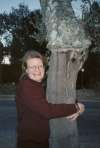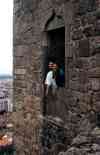|
|
The town of Castelo Branco was well fortified as it lay strategically close to the Spanish boarder. Nevertheless, it suffered a number of invasions and occupations, events that did not leave many historical monuments. To the contrary, these invasions were distructive. The maraudings of the Napoleonic troops in 1807 were among the most devastating. The scant ruins of the Templar's stronghold tower above the town are all that remains of the fortifications. Castelo Branco, the capital of the Beira Baixa region, is today, a peaceful, flower bedecked city living by it trade in cork, cheese, honey, and olive oil. It is particularly known for the fine bedspreads (cholchas) embroidered in different colors by young girls, who perpetuate a tradition going back to the 17th century, as each prepares her trouseau. Castelo Branco is very hot in the summer and cold in the winter because of its relatively high altitude.
|
|
|
Source: Michelin Tour Guide to Portugal
|
|
|
One of the most beautiful gardens in Northern Portugal is located in Castelo Branco. It is known as the Jardim do Antigo Pašo Espicopal. It is associated with the local parish. The 17th century gardens belonged to the Episcopal Palace. There are clipped box trees and hedges, flowers, oramental pools and many baroque statues of the signs of the zodiac, Doctors of the church, the seasons, the Virtues and many others. There is a staircase lined with statues of all the kings of Portugal. The scultor made the statues of the Spanish dominated kings smaller than the others. Originally, these statues were cast in bronze. However, when Napoleon┤s army invaded Portugal, they melted the statues to make cannon balls. After the war they were redone in stone.
|
|

Click to enlarge |
A view of the eastern part of the city from the ruins of the castle.In the background you can see the broad plain where the city resides. The castle occupies the top of the largest mount in the area. This picture was taken at sun down.
|
|
|
This is a picture of some members and missionaries in the front of the older chapel. The chapel occupied the ground floor suite in a residential and office building. The missionaries are Elders Rudser and Baird, and Sisters Frandsen and Riding.
|

Click to enlarge |
|

Click to enlarge |
Sister Krehbiel hugs a cork tree. The area south of Castelo Branco has acres and acres of cork trees. The cork comes from the bark of the trees. The bark is stripped from the tree trunk and from the large branches. Since the thick bark is left on the smaller branches, the tree looks like it has a poodle cut. The year the bark is stripped is painted on the trunk. Then, in about 10 years, when the bark has grown back, it is ready to be harvested again.
|
|
|
This is a picture of the cork bark after it has been removed from the trees. The bark is then loaded on to large trucks similar to semi┤s from the united states and taken to other parts of Portugal to be processed. This picture was taken from the book, Savouring Spain and Portugal.
|

Click to enlarge |
|
|
There are only partial remains of the one remaining tower of the castle in Castelo Branco. In this picture you can get a sense of the craftsmanship that stone cutters who create the window molding out of stone. Pictured are Nicole West and her friend, Karen Hart. While little remains of the original castle, the hill top is a restful location with a church, some gardens and woods. Because the surrounding area is very flat, this is a beautiful spot to enjoy a sun rise or a sun set.
|

|
|

|
This is a view of the lovely gardens of Castelo Branco. In the foreground you can see the stone statues of all the Kings of Portugal. These are the statues that were originally made of bronze. These are some of the prettiest gardens in Northern Portugal
|
|

